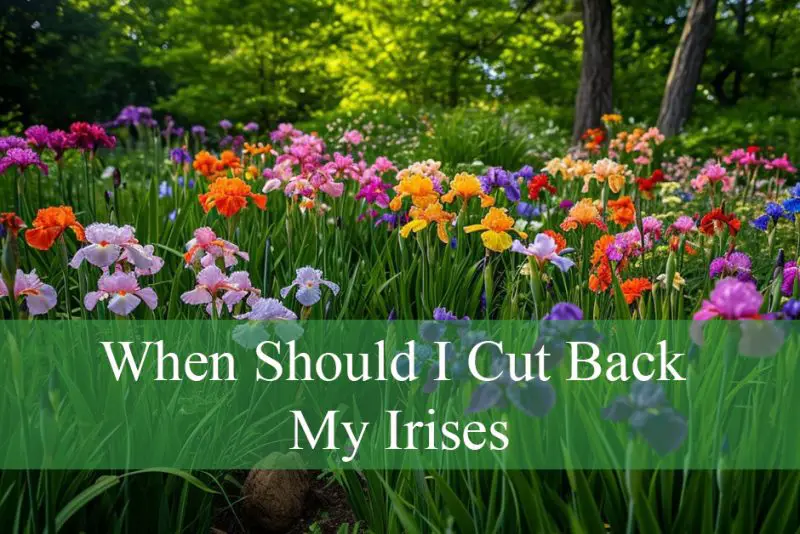Irises are among the most beloved perennial flowers for their sword-like foliage and intricate blooms that add timeless elegance to gardens. However, to keep these stunning plants healthy and blooming profusely year after year, it’s essential to understand the timing and techniques for cutting them back. Knowing when and how to prune irises doesn’t just improve their appearance — it directly impacts their flowering cycle and disease resistance.
Cutting back irises at the right time can prevent rot, deter pests, and promote vigorous growth for the next blooming season. But if done too early or incorrectly, it can stress the plant or even compromise future blooms. This comprehensive guide walks you through the ideal timing, seasonal considerations, and practical insights to help you confidently prune your irises for the best results.
Understanding the Iris Life Cycle

Before deciding when to cut back irises, it’s important to understand their natural life cycle. Irises grow from rhizomes, which store nutrients and energy throughout the year. Their life cycle involves a phase of active growth, blooming, and a period of dormancy. Each phase plays a vital role in determining the ideal pruning schedule.
In early spring, new foliage begins to emerge as the rhizomes awaken from winter dormancy. Buds soon follow, leading to the spectacular display of blooms typically occurring from late spring to early summer, depending on the variety. Once the blooms fade, the plant gradually redirects energy to the rhizomes to prepare for the next season. This post-bloom phase is critical, as the foliage continues to photosynthesize and store nutrients.
As the weather cools in late summer and fall, the foliage starts to yellow and die back. This is nature’s signal that the plant is entering dormancy. During this time, cutting back becomes not only safe but beneficial, helping to clean up dead material and protect the plant from disease and winter damage.
Cutting Back After Blooming: Timing and Reasons
Post-bloom care is one of the most important pruning periods for irises. Once your irises have finished flowering in late spring or early summer, the spent flower stalks can be removed promptly. This prevents the plant from wasting energy on seed production and encourages stronger rhizome development.
However, it’s important not to remove the green foliage too early after blooming. The leaves are still actively providing energy through photosynthesis. If cut back prematurely, the plant may enter stress mode and produce fewer flowers in the following year. The general recommendation is to leave the foliage intact until it begins to yellow naturally, which often occurs in late summer.
Deadheading and trimming the flower stalks help maintain the plant’s appearance and reduce the risk of fungal diseases. This practice also minimizes clutter in the garden and improves airflow around the plant. Timing your post-bloom pruning carefully ensures that your irises continue to thrive without compromising future blooms.
Late Summer and Fall: Ideal Time for Full Cutback
Late summer into early fall is typically the best time for a full cutback of iris foliage. Around August to October, depending on your local climate, the leaves begin to lose their green color and turn brown or yellow. This signals the beginning of the plant’s dormancy period and is your cue to trim it down.
Cutting back irises in the fall serves multiple purposes. It reduces the habitat for overwintering pests, removes diseased or decaying foliage, and keeps the garden looking tidy through the colder months. Most gardeners cut the foliage back to about 4 to 6 inches above the rhizome. This short remaining length helps protect the rhizome while minimizing the risk of rot and other fungal issues.
Trimming during this period also allows gardeners to divide and transplant irises if necessary. This is often done every 3 to 5 years to prevent overcrowding and rejuvenate older clumps. Fall pruning creates the perfect opportunity for division, as the plant is naturally slowing down its activity and more tolerant of disturbance.
Seasonal Climate Differences and Regional Factors
The specific timing for cutting back irises can vary depending on your geographic location and climate. In colder northern regions, iris foliage may begin to die back earlier due to frost, while in warmer southern climates, the process may be delayed. Understanding your USDA hardiness zone can help you fine-tune your pruning schedule to match local conditions.
For instance, in USDA zones 3 through 6, the first frost may arrive by late September or early October. Gardeners in these regions often begin cutting back iris foliage in early to mid-fall to stay ahead of the cold. In contrast, zones 7 through 10 may allow for later pruning, sometimes into November, as the warmer temperatures keep the foliage green longer.
Regardless of location, one rule remains consistent: wait until the leaves begin to yellow or brown before removing them. Green leaves are still working to fuel the rhizomes, and early removal can stunt the plant’s future growth. By monitoring your iris plants closely, you can adjust your pruning window to reflect the unique needs of your growing environment.
The Role of Clean-Up in Disease Prevention
Cutting back iris foliage isn’t just about aesthetics or seasonal habit — it’s a critical component of disease prevention. Irises are prone to issues such as iris leaf spot, bacterial soft rot, and fungal infections that thrive in warm, moist environments and decaying plant material. Removing old foliage reduces the likelihood of these diseases taking hold.
Leaf spot, for example, causes unattractive brown or black spots on iris leaves and can spread rapidly during humid summer conditions. Removing infected leaves and cleaning up debris around the plant helps to break the cycle of infection. Pruning the foliage back during the late growing season also minimizes fungal spores that could overwinter and cause problems the following spring.
Using clean, sharp pruning tools is essential to prevent the spread of disease between plants. Always sanitize your shears before and after cutting back each clump. Discard the old foliage in the trash rather than composting it if there are visible signs of disease. This proactive approach protects your irises and encourages healthier blooms the next year.
Cutting Back Different Iris Varieties
While the general guidelines for pruning apply broadly to irises, it’s helpful to note that different iris types may have slightly different care requirements. Bearded irises, one of the most popular types, benefit from post-bloom trimming and full fall cutback. Their thick rhizomes are especially vulnerable to rot if old foliage is left to decay.
Siberian and Japanese irises, which tend to have thinner leaves and a clumping growth habit, may not require as aggressive pruning. Their foliage often remains green longer into the fall and may be left until just before winter. However, once the leaves start to brown, cutting them back helps maintain the plant’s health and garden appearance.
Louisiana irises, adapted to wet or boggy soils, are another type that may require different pruning timing. These often maintain green foliage longer than other types, especially in southern climates. Cutting back should still occur in late fall or early winter when the foliage dies back naturally. Adjusting your pruning approach based on iris variety ensures each type receives the most suitable care.
Division and Pruning: A Perfect Pair
Cutting back your irises in the fall is often paired with dividing the rhizomes, a process that rejuvenates old plants and prevents overcrowding. Over time, iris clumps can become too dense, reducing airflow and increasing competition for nutrients. This leads to fewer flowers and more susceptibility to disease.
After trimming back the foliage, carefully dig up the clump and separate the rhizomes. Discard any mushy or damaged segments, and replant the healthy pieces in well-draining soil. Space the rhizomes about 12 to 18 inches apart with the tops just at or slightly below soil level. The trimmed foliage helps the plant conserve energy and direct resources to root establishment.
By combining pruning and division in one seasonal chore, you maximize the health and blooming potential of your irises. This process, though labor-intensive, pays off with vibrant blooms and lush growth in the seasons to come.
Winter Preparation and What to Expect
Once your irises have been trimmed back and cleaned up for winter, there’s little left to do until spring. The trimmed foliage will dry and fade, and the rhizomes will remain dormant through the colder months. A light layer of mulch can be applied in regions with harsh winters, but be careful not to bury the rhizomes, as this can trap moisture and cause rot.
During the winter, it’s important to monitor for signs of animal damage, particularly from rodents that may nibble on the rhizomes. If you notice disturbances in the soil, consider protective measures like mesh coverings or repellents. Avoid heavy watering during this time, as dormant rhizomes require minimal moisture.
Come early spring, you’ll begin to see new shoots emerging from the rhizomes. This signals the end of dormancy and the start of a new growth cycle. With proper fall cutback and cleanup, your irises will be well-positioned to produce healthy foliage and abundant blooms.
Common Mistakes to Avoid When Cutting Back Irises
While cutting back irises is a fairly straightforward task, several common mistakes can undermine your efforts. One frequent error is cutting the foliage too early, especially when it is still green and actively photosynthesizing. Doing so deprives the rhizome of energy and may result in weak growth or fewer flowers.
Another mistake is failing to clean tools between cuts, which can spread diseases from plant to plant. Always sanitize your shears or scissors with alcohol or a diluted bleach solution. Over-trimming is also problematic; leaving too little foliage can expose the rhizome to extreme weather or desiccation.
Neglecting to remove diseased or pest-ridden debris can invite issues that linger into the next season. Always inspect the leaves for spots, holes, or mushy textures and dispose of them properly. By avoiding these pitfalls, you help create a healthier environment that supports long-term iris success.
FAQ About Cutting Back Irises
When should I cut back my irises after blooming?
You should cut back the flower stalks immediately after blooming to redirect energy to the rhizomes, but keep the green leaves intact until they begin to yellow naturally, usually in late summer.
Is it OK to cut iris leaves back in summer?
It’s not recommended to cut healthy green leaves during summer. They are still photosynthesizing and helping the plant store energy. Wait until they turn yellow or brown in late summer or early fall.
What happens if I don’t cut back my irises?
If left untrimmed, dead foliage can attract pests, harbor disease, and lead to rot. It also creates a messy appearance and can reduce blooming vigor the next season.
Do all types of irises need to be cut back?
Yes, but timing may vary slightly. Bearded irises should be trimmed in fall. Siberian and Japanese irises can be left a little longer until leaves die back. All benefit from fall cleanup for health and performance.
Can I cut back irises in spring?
Spring is not the ideal time for cutting back irises. Pruning should be done in late summer to fall. In spring, focus on removing any leftover debris and letting new shoots grow.
Final Thoughts on Pruning for Better Iris Blooms
The question of when to cut back irises isn’t just about calendar dates — it’s about understanding the plant’s natural rhythms and responding to environmental cues. Timing your pruning to coincide with the end of blooming and the beginning of dormancy ensures that you’re supporting both the plant’s health and its visual appeal.
By practicing thoughtful seasonal care, you can enjoy an abundant display of iris blooms year after year. From removing spent flower stalks in summer to trimming browning leaves in the fall, each step plays a role in encouraging stronger, more vibrant flowering. With the right approach and timing, your irises will reward you with breathtaking blooms and robust growth that elevates any garden space.






